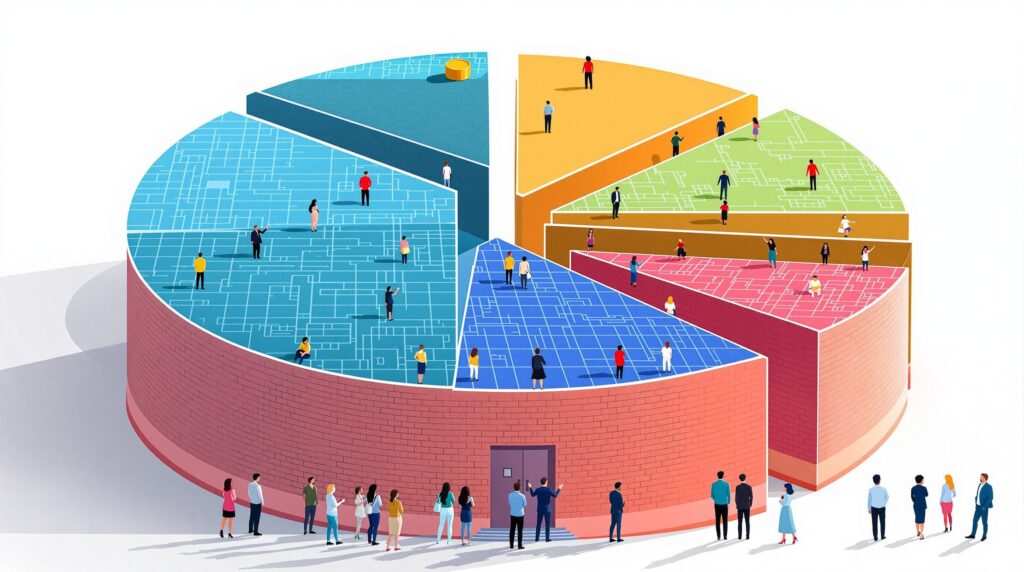[rev_slider alias=”slider-1″][/rev_slider]
Introduction to Layer 1 Blockchains
Understanding the basics of Layer 1 blockchains is pivotal if you’re diving into the realm of blockchain technology. You might be asking, what exactly are these Layer 1 blockchains? Well, they’re the foundational layer within the blockchain ecosystem, akin to the roots of a tree supporting various branches. These blockchains, decentralized in nature, support on-chain transactions that validate and transmit data without needing a separate network, which is not just fascinating but also transformative in the world of digital assets.
Key Features and Benefits
Layer 1 blockchains come packed with key features that set them apart, increasing their speed and efficiency in unprecedented ways. Let’s break it down:
- Scalability: Many Layer 1 blockchains are designed to handle a high transaction count by improving agility while maintaining decentralization. This is vital for processing numerous transactions per second, much like how highways expand to manage increased traffic.
- Decentralization: They operate on a decentralized network of nodes, eliminating any single point of failure. This robust structure ensures that no entity has control over the entire network, like a democracy operating with numerous voices instead of a single leader.
Why are Layer 1 blockchains significant? They serve as the backbone of blockchain networks, supporting functionalities that promote security, decentralization, and scalability.
One might wonder why this matters, especially in the growing digital economy of Africa. Layer 1 blockchains form the basis for any advanced Layer 2 solutions, offering an essential infrastructure upon which further technological advancements and applications are built. With speedy transactions and efficient operations, these blockchains facilitate everything from digital payments to secure asset management.
At Jara, we harness the capabilities of $JARA through our proprietary Layer 2 blockchain. It’s like having your cake and eating it too—rapid transactions with minimal cost, secured by the trusted infrastructure of a Layer 1 base. This approach revolutionizes economic inclusion and provides a seamless integration for tokenized assets in Africa’s burgeoning digital landscape.
All of these developments not only enhance the technological frameworks within Africa but also create a ripple effect, offering foreign investors enticing opportunities to participate in transformative projects, such as our Lagos airport tokenization initiative. This growing interconnected network driven by Layer 1 blockchains is shaping a new financial reality, bridging global capital with African assets in a secure and efficient manner.
Factors Influencing Speed in Layer 1 Blockchains
When it comes to blockchain technology, not all Layer 1 blockchains are created equal. What makes some of these systems faster than others? Several factors come into play, from consensus algorithms to the size of blocks and the throughput of transactions, each element plays a crucial role in determining the speed and efficiency of a blockchain.
Consensus Algorithms
What is a consensus algorithm, and how does it affect blockchain speed? A consensus algorithm is a mechanism used by blockchains to agree on a single version of the truth. Simply put, it determines how transactions are validated and added to the blockchain. Popular consensus algorithms include Proof of Work (PoW), Proof of Stake (PoS), and Delegated Proof of Stake (DPoS), each having different characteristics affecting speed:
- Proof of Work (PoW): While PoW is known for its security, it often results in slower transaction times due to its high computational demand.
- Proof of Stake (PoS): PoS typically offers faster transaction times since it selects validators based on their stake in the network, reducing the need for intensive computation.
- Delegated Proof of Stake (DPoS): As an evolved form of PoS, DPoS further increases speed by allowing token holders to elect delegates who validate transactions on their behalf.
Block Sizes and Transaction Throughput
Have you ever wondered how block size impacts blockchain speed? Block size refers to the amount of data, or transactions, a single block can hold. Larger blocks can process more transactions at once, theoretically increasing speed. However, there are trade-offs:
- Large Block Sizes: These can lead to faster transaction processing times, but also require more storage and bandwidth.
- Small Block Sizes: While easier to manage, smaller blocks may lead to transaction bottlenecks during peak periods.
The potential for higher transaction throughput is essential for any blockchain vying for widespread adoption. Aspects like node performance and network bandwidth also impact how swiftly transactions are validated and added to the chain. Network upgrades like SegWit (Segregated Witness) have been implemented in some networks to optimize these factors.
Comparison with Slower Counterparts
Why do some blockchains lag behind despite advancements? Understanding the slower counterparts involves examining their inherent technological and infrastructural limitations. For instance, some blockchains may prioritize security and decentralization over speed, which can result in slower transaction times. Conversely, networks such as Ethereum and Bitcoin focus on the security of digital assets, which can naturally slow down their process.
What factors make some Layer 1 blockchains faster? Consensus algorithms, block sizes, and transaction throughput significantly affect the speed of Layer 1 blockchains. These elements combined play a pivotal role in the overall performance and efficiency of blockchain systems.
In conclusion, while speed is a critical component of blockchain performance, it’s essential to weigh it against other crucial factors like security and decentralization. Each blockchain must find its own balance in optimizing these components to meet its specific goals and community needs across platforms like $JARA, which seeks to empower the African digital asset economy.
[rev_slider alias=”text-call-cta”][/rev_slider]
Importance of Speed in Blockchain Technology
Speed is a crucial factor in the widespread adoption and effectiveness of blockchain technology. In the fast-paced digital world, the difference between a transaction taking seconds versus minutes can be substantial. This is why faster Layer 1 blockchains are becoming increasingly vital. They not only enhance transaction times but also improve overall operational efficiency and user experience.
Why does speed matter in blockchain technology? Faster blockchain transactions enhance user experience and trust in the system, which is essential for broader market adoption.
Consider the scenario of making a purchase online. If you had to wait an extended period for your payment to process due to slow blockchain transactions, your user experience would be negatively impacted. Fast processing speeds in Layer 1 blockchains ensure that transactions are completed promptly, making the entire process smoother and more reliable.
Implications for User Adoption and Business Applications
The speed of blockchain transactions directly influences user trust and the expansion of blockchain applications across various sectors. When it comes to user adoption, a seamless experience can drive more people to engage with blockchain-based applications, from financial services to supply chain management. Businesses also see the value in faster blockchain speeds, which can significantly enhance operation efficiency.
- Enhanced Trust: With faster transactions, users perceive the system as more reliable, which in turn nurtures trust.
- Competitive Edge: Businesses utilizing faster blockchains can offer quicker services, giving them an edge in a competitive market.
- Wider Application: Quicker transaction speeds facilitate the integration of blockchain technology into diverse sectors, such as healthcare, real estate, and logistics.
- Cost Efficiency: Operational costs could potentially decrease as efficiency improves, benefitting both businesses and consumers.
By increasing speed, Layer 1 blockchains also reduce the strain on the overall system—the more efficient the operation, the better the performance. It thereby opens doors to innovative applications that rely on high-speed transactions, such as real-time trading platforms and instant payment solutions, boosting industry growth.
Ultimately, as Africa undergoes a rapid digital transformation, adopting faster Layer 1 blockchains could greatly support financial inclusion. Advanced blockchain technology, like the one developed by Jara, aims to bridge global capital with African assets, further underscoring the transformative power of high-speed blockchains in the continent’s burgeoning digital economy.
Layer 1 vs. Layer 2 Solutions
Understanding the distinction between Layer 1 and Layer 2 blockchain solutions is pivotal in comprehending their roles in enhancing blockchain efficiency, particularly in areas of scalability and speed. Simply put, while Layer 1 refers to the base level of blockchain architecture, enjoying widespread recognition for its foundational role, Layer 2 operates on top of Layer 1, addressing limitations such as scalability.
Layer 1 Blockchains:
- Scalability Limitations: As the number of transactions increases, Layer 1 blockchains can slow down, leading to bottlenecks.
- Decentralization: They are the main chain, ensuring high security and immutability.
- Security Measures: Relying on consensus mechanisms such as Proof of Work (PoW) or Proof of Stake (PoS), they maintain a high security standard.
Layer 2 Solutions:
- Off-Chain Processing: They operate off the main chain, primarily to reduce congestion and enhance transaction throughput.
- Faster Transactions: By processing transactions off-chain and later recording them in bulk on Layer 1, they can drastically increase transaction speeds.
- Lower Fees: With reduced congestion comes lower transaction costs, making micro-transactions more feasible.
Layer 1 solutions provide the foundational security and decentralization, while Layer 2 solutions enhance scalability and transaction speeds by operating off-chain.
Advantages of Layer 1 and Layer 2 Integration
By integrating both Layer 1 and Layer 2 solutions, the blockchain community can leverage the best of both worlds. This integration isn’t merely about stacking layers but rather creating a symbiotic relationship where the weaknesses of one are addressed by the strengths of the other.
Key Benefits of Integration:
- Enhanced Scalability: The combination allows the blockchain to handle a much larger volume of transactions than what would be possible with Layer 1 alone.
- Reduced Transaction Costs: By utilizing Layer 2 for off-chain transactions, users can benefit from lower fees, enhancing the usability of blockchain for everyday transactions.
- Improved User Experience: Faster transaction times and lower fees lead to a more efficient and user-friendly network, critical for mainstream adoption.
- Seamless Interoperability: This hybrid approach fosters an environment where various applications and services can interact smoothly, benefiting from both security and efficiency.
Integrating Layer 1 and Layer 2 solutions combines the foundational strengths of Layer 1 with the scalable efficiencies of Layer 2, paving the way for a robust blockchain ecosystem.
The strategic application of Layer 1 and Layer 2 blockchain solutions is pivotal for platforms like Jara, which seek to bolster Africa’s digital infrastructure significantly. Jara’s ecosystem employs a proprietary Layer 2 blockchain to facilitate fast and cost-effective transactions, essential for tokenizing real-world assets within a rapidly evolving market landscape. This approach not only meets the demands of modern digital economies but also positions platforms to deliver scalable and efficient financial services across vast markets.
By capitalizing on the unique capabilities of Layer 1 and Layer 2, Jara is poised to tap into Africa’s burgeoning digital revolution. This synergy is not just a technical requirement but an economic catalyst, enabling digital economies to flourish where traditional systems fall short.
[rev_slider alias=”schedule-consultation-btn”][/rev_slider]

Why are some Layer 1 blockchains faster than others?
Layer 1 blockchains differ in speed due to various factors such as consensus algorithms, block sizes, and transaction throughput. For instance, blockchains that employ a Proof of Stake (PoS) consensus tend to be faster than those using Proof of Work (PoW) due to reduced computational requirements.
How does blockchain speed affect transaction costs?
Faster Layer 1 blockchains generally have lower transaction costs because they can handle more transactions at once, reducing congestion and fees. When a blockchain is slow, users may compete by offering higher fees to prioritize their transactions, increasing overall costs.
What role do consensus algorithms play in blockchain speed?
Consensus algorithms are crucial as they determine how transactions are validated and added to the blockchain. Algorithms like Proof of Stake and Delegated Proof of Stake are designed for speed and efficiency, offering faster transaction processing compared to more resource-intensive algorithms like Proof of Work.
Why is the speed of a Layer 1 blockchain important for users?
Speed is vital for users because it affects the overall user experience. Faster blockchains enable quick transaction confirmation, making applications more responsive and appealing. This is especially important for industries like finance, where delays could lead to significant opportunity costs.

Factors Influencing Speed in Layer 1 Blockchains
Examine the various technical and infrastructural elements that enable certain Layer 1 blockchains to operate faster than others. Analyze consensus algorithms, block sizes, and transaction throughput.
Comparison with Slower Counterparts
Provide insights into why some Layer 1 blockchains may lag in speed, comparing technological limitations and improvements.
Additional Practice Areas
Explore our diverse range of practice areas to understand how we can assist with various blockchain-related needs.
Hear From Our Satisfied Africa Clients
Serving our Layer 1 and Layer 2 blockchain solutions clients with complete dedication, every case is a testament to our hard work. The appreciative feedback we receive underscores our commitment to excellence.

[rev_slider alias=”slider-3″][/rev_slider]
[rev_slider alias=”slider-6″][/rev_slider]
Partner with Us for Your Blockchain Solutions
In the competitive landscape of blockchain technology, the speed and efficiency of Layer 1 blockchains are paramount. At Jara, we specialize in bridging global capital to African assets through cutting-edge Layer 1 and Layer 2 blockchain solutions. Let us help you navigate these technological advancements with confidence and expertise.
Boost your blockchain performance with Jara’s state-of-the-art solutions. Download the Jara app on Android or iPhone today and explore our offerings!
Awards and Recognition
But don’t just take our word for it. Our commitment to excellence has been recognized through several prestigious awards, solidifying our position in the blockchain industry:
- Innovative Blockchain Solution 2023: Awarded by the Tech Innovators Conference. Recognized for outstanding development in blockchain applications. Learn more.
- Top Blockchain Innovators 2023: Named among the best by Blockchain Week USA for pioneering scalability solutions. Discover more.
- Excellence in FinTech 2023: Granted by the Global Tech Forum, highlighting our contributions to financial technology innovations. Explore details.
- Best Emerging Tech Company 2023: Highlighted by the Emerging Tech Awards for exceptional growth and innovation in technology sectors. Find out more.
- Top Blockchain Development Firm 2023: Recognized by the Development Authority for cutting-edge solutions in blockchain development. See the list.
Experience firsthand why we are leaders in the field. Connect with us at [email protected] and let’s discuss how we can elevate your blockchain ventures.
Chinyere “Chi” Nnadi Bio
Founder and CEO, Jara | Blockchain Technology Specialist
Content Reviewed by Chi Nnadi and his Content Team. Chi is an experienced leader committed to revolutionizing Africa’s financial landscape via blockchain. Under Chi’s guidance as the Founder and CEO of Jara, the company constructs enterprise-level infrastructure that transforms African assets into globally compatible digital tokens. His mastery in blockchain technology aids in linking global investors with Africa’s burgeoning digital market.
Our Content Review Process
Chi Nnadi along with Jara’s dedicated content team, pledge to offer top-notch material. Our content guidelines ensure thoroughness, reputable sources, unbiased scrutiny, among other quality metrics. Please let us know if there is anything you believe to be inaccurate.
















